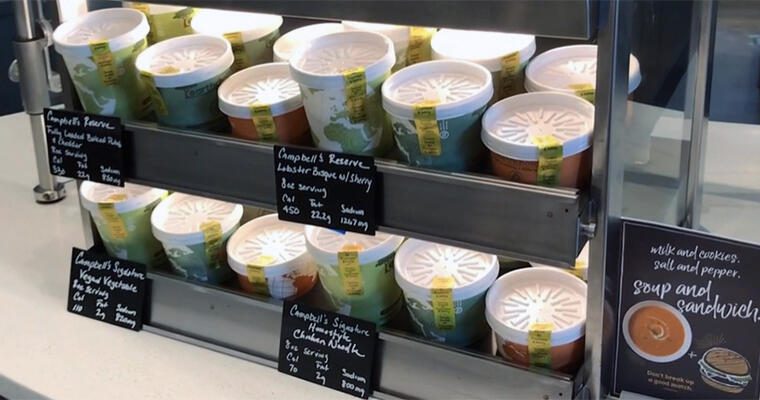During the pandemic’s toughest months, retail self-serve bars took a huge hit. Food moved behind the line when it was available at all. Now that business is reopening, hospitals and other care settings are looking at the future of build-your-own meals with safety and labor concerns in mind.
Operational updates have addressed the risk of spreading COVID-19 by contact. Solutions included hand sanitizer stations, gloves, frequently replaced serving utensils and individual condiment packets—practices likely to continue.
Bringing back salad bars, hot soup self-service, build-your-own deli sandwiches, meal action stations and even normal hours of operation will take more than safety considerations in today’s marketplace. Complete reopening will depend on regulations, consumer confidence and staffing.
Before the pandemic, about half of the food served at non-commercial retail operations was from self-serve bars, Sandridge Food Corp. Regional Sales Manager Don Hubert estimates. Returning to anywhere near that level, he believes, calls for repurposing self-serve bars. It’s a path to managing labor pressures, food availability and offering consumers variety.
Self-serve show and tell
One way to make the most of self-serve bars starts with communicating menu availability.
For example, when soup moved behind the line for pandemic safety reasons, it was out of sight, out of mind. For continued sales, it’s really important to have signage telling consumers where to get a bowl of soup.
For operators, soup has always been an efficient self-serve component. Ready-to-serve products save time, labor and provide consistency and choice—something that takes a lot of time even in the best scratch kitchen.
There’s no reason to give up on soup just because customers are unable to ladle a bowl for themselves. All it takes is some simple retrofitting of space you already have to create a grab-and-go version of self-serve.
One way to accomplish this is to place warming plates over the top of existing soup wells. Another option is a two-tier warming unit. Both allow pre-portioned soups in 8-, 12- or 16-oz. containers to be on display, hot and ready for grab-and-go.
It takes some planning and equipment, and it’s important to monitor the soup to maintain its heat and integrity. Soup can be replenished by the back of house when needed, so operator labor is limited to mostly monitoring.
Soup is a valuable asset to both the self-serve bar and the overall menu. Soup can be a recipe base, a sauce in speed-scratch cooking, or a way to flavor dressings and sandwich spreads. For example, Roasted red pepper and smoked gouda soup can become a pasta sauce or flavoring spread atop seafood.
Self-serve variety and waste reduction
Versatile, ready-to-assemble products are exactly the approach Sandridge recommends. It’s a great way for operators to add variety, control costs, cut waste and manage labor, Hubert points out.
“There are some places that have opened back up their bars with a smaller menu, and we wanted to come up with a way to give them just a couple of SKUs that don’t require preparing 25 different ingredients in the back of the house,” he said. “If I can buy all this stuff that’s premade, ready to go, refrigerated, I can just heat it, portion it out and have one person putting together 30 to 40 meals in a half an hour. You package it, put a sticker on it and put it out there for self-serve grab-and-go.”
It can be as simple as pre-cooked pasta or mac and cheese, Hubert said. Remove it from a pouch, offer a couple of fresh ingredients to make it your own, and guests can customize it to suit their appetites.
“You don’t need a culinary degree. Start with 8 oz. of mac and cheese, an ounce of green pepper, an ounce of pepperoni, some hot sauce… these are very simple things people can work with.”
Beyond the simplicity is the savings. Sandridge has created a collection of options that Hubert notes are all 100% usable products, with no cooking required and no wasted ingredients.
Self-serve labor savings and beyond
Simple recipes and pairings also offer labor efficiency, says Sandridge Head Chef Dan Zakri. Hiring workers is not the only challenge today. Sandridge also considered training and retention.
“These meals don’t require a lot of time and effort to train someone for prep,” Zakri said. “It’s also easy to implement at stationary self-serve bars, mobile carts, or even to bring into a room and customize.”
And because retaining labor is important, Zakri believes these kinds of meals can help with employee satisfaction. As with the Tastefully Balanced meals created by Sandridge and Gordon Food Service, these foods can be prepared as meals for staff. They work as either a quick lunch or can be packaged family-style to take home.
“Our goal was to find a solution to help operators start making money again,” Zakri said. I think operators are going to continue to look for efficiencies in different ways, and these are effective ways of getting food to people in very challenging times.”




























